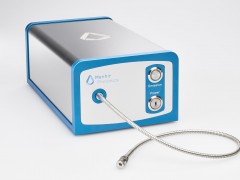
Laser Simulations Model Impact of Nuclear Explosions on Asteroids
source:Photonics
release:Nick
Time:2018-03-21
MOSCOW, March 19, 2018 — Researchers constructed miniature asteroids and blasted them with a laser to model the impact of a nuclear explosion on an asteroid threatening to collide with Earth. The research team showed that a brief laser pulse aimed at a miniature replica of an asteroid could produce effects similar to those of a nuclear explosion on an actual space rock.
The properties of the asteroid model were manufactured to precisely correspond with the composition and proportions of an actual asteroid. To confirm the similarity of key processes in the model and full-scale asteroid, the team from Rosatom and Moscow Institute of Physics and Technology (MIPT) performed compressible flow calculations.
The experiments made use of three laser devices: Iskra-5, Luch and Saturn. The laser beam was first amplified to a predetermined power and then directed at the asteroid replica fixed in a vacuum chamber. Model destruction was monitored from behind and from the side, and fragmentation dynamics were registered. The laser was used on the model asteroids for 0.5 to 30 ns.
In some of the experiments, the laser was targeted at a cavity made in the miniature asteroids prior to irradiation. By exploiting the cavity, the researchers spent 500 instead of 650 J/g.
based on calculations showing that it would take a 500-J laser pulse to destroy a model 8 to 10 m in diameter, the team was able to determine that to eliminate a 200-m asteroid in space, a nuclear explosion would need to deliver the energy equivalent of 3 megatons of TNT.
The researchers were also interested in whether the explosion effect was cumulative, that is, if one powerful explosion could be replaced by a succession of smaller ones. They found that multiple weaker laser pulses provided no significant advantage over a single pulse of equal power, regardless of whether the series of weaker pulses was simultaneous or consecutive.
The research team plans to expand the study by experimenting with asteroid replicas of different composition, including those containing iron, nickel and ice. It also intends to identify more precisely how the shape of the asteroid and the presence of cavities on its surface affect the general destruction criterion.
“At the moment, there are no asteroid threats, so our team has the time to perfect this technique for use later in preventing a planetary disaster,” said professor Vladimir Yufa of MIPT. “We’re also looking into the possibility of deflecting an asteroid without destroying it.”
The research was published in Journal of Experimental and Theoretical Physics
The properties of the asteroid model were manufactured to precisely correspond with the composition and proportions of an actual asteroid. To confirm the similarity of key processes in the model and full-scale asteroid, the team from Rosatom and Moscow Institute of Physics and Technology (MIPT) performed compressible flow calculations.
The experiments made use of three laser devices: Iskra-5, Luch and Saturn. The laser beam was first amplified to a predetermined power and then directed at the asteroid replica fixed in a vacuum chamber. Model destruction was monitored from behind and from the side, and fragmentation dynamics were registered. The laser was used on the model asteroids for 0.5 to 30 ns.
In some of the experiments, the laser was targeted at a cavity made in the miniature asteroids prior to irradiation. By exploiting the cavity, the researchers spent 500 instead of 650 J/g.
based on calculations showing that it would take a 500-J laser pulse to destroy a model 8 to 10 m in diameter, the team was able to determine that to eliminate a 200-m asteroid in space, a nuclear explosion would need to deliver the energy equivalent of 3 megatons of TNT.
The researchers were also interested in whether the explosion effect was cumulative, that is, if one powerful explosion could be replaced by a succession of smaller ones. They found that multiple weaker laser pulses provided no significant advantage over a single pulse of equal power, regardless of whether the series of weaker pulses was simultaneous or consecutive.
The research team plans to expand the study by experimenting with asteroid replicas of different composition, including those containing iron, nickel and ice. It also intends to identify more precisely how the shape of the asteroid and the presence of cavities on its surface affect the general destruction criterion.
“At the moment, there are no asteroid threats, so our team has the time to perfect this technique for use later in preventing a planetary disaster,” said professor Vladimir Yufa of MIPT. “We’re also looking into the possibility of deflecting an asteroid without destroying it.”
The research was published in Journal of Experimental and Theoretical Physics
MOST READ
- RoboSense is to Produce the First Chinese Multi-beam LiDAR
- China is to Accelerate the Development of Laser Hardening Application
- Han’s Laser Buys Canadian Fiber Specialist CorActive
- SPI Lasers continues it expansion in China, appointing a dedicated Sales Director
- Laser Coating Removal Robot for Aircraft
PRODUCTS
 FISBA exhibits Customized Solutions for Minimally Invasive Medical Endoscopic Devices at COMPAMED in
FISBA exhibits Customized Solutions for Minimally Invasive Medical Endoscopic Devices at COMPAMED in New Active Alignment System for the Coupling of Photonic Structures to Fiber Arrays
New Active Alignment System for the Coupling of Photonic Structures to Fiber Arrays A new industrial compression module by Amplitude
A new industrial compression module by Amplitude Menhir Photonics Introduces the MENHIR-1550 The Industry's First Turnkey Femtosecond Laser of
Menhir Photonics Introduces the MENHIR-1550 The Industry's First Turnkey Femtosecond Laser of Shenzhen DNE Laser introduced new generation D-FAST cutting machine (12000 W)
more>>
Shenzhen DNE Laser introduced new generation D-FAST cutting machine (12000 W)
more>>

